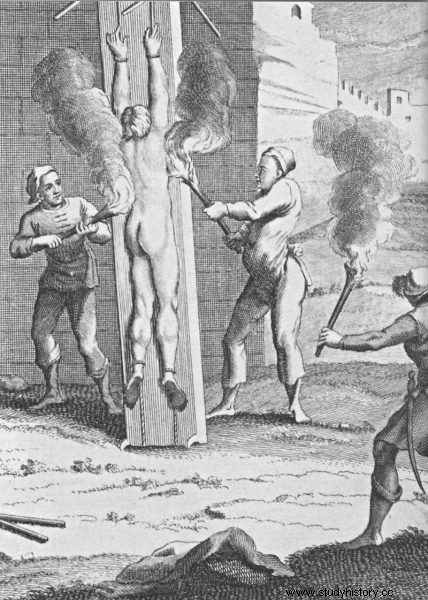Forensic torture has fired the imagination for many decades. The sense of their use is discussed lively, and the sophisticated tools allegedly used by modern executioners are admired with fascination. Is everything we think about torture before Polish municipal courts true?
In my previous text it was mentioned that Polish executioners were selected by the city authorities mainly from among criminals sentenced to death. However, the low-spirited masters did not enjoy a flattering opinion in Poland. They were ostracized and pushed out of society , in effect forcing them to continue to be part of the same circle of criminals from which they were recently dragged. It brought with it a far-reaching conflict of interest:the executioner, who after "working hours", made extra money on the side by robbing houses or robbing roads, during court torture was not too eager to use particularly sophisticated techniques against his friends. There was, however, the other side of the coin - the city's torturers were chosen at random. They were often not properly trained, and most of them did not have the necessary skills to use more sophisticated and effective methods of tormenting the accused. For this reason the wide range of modern court torture in Polish conditions was most often limited to stretching, breaking joints and burning the body.

One way of torture was to roast the flesh
Torture - a regulated matter?
The course of court torture in the cities of Central and Eastern Europe was largely regulated by Constitutio Criminalis Carolina issued by Emperor Charles V in 1532. which was the law in force in the German states. Outside the Empire, it inspired how the city's criminal trial should proceed. Carolina it therefore stated, inter alia, that torture should be graded (from light to heavier) each successive series could not last longer than an hour, had to be separated by several-hour breaks, and they themselves could not be used more than three times. If the accused did not plead guilty after the third series of torture, he was innocent and must be released home.
In Polish cities, Carolina recipes was used with different attention to detail. Very often there were no breaks between successive series of tortures, and when the first ended and the second began, only a short interlude in which the judges once again asked the accused whether he admitted to having committed the charges against him. In witchcraft trials, it was common for many courts to ignore the acquittal principle after the third round of torture, during which the accused did not plead guilty. The rationale behind this was that the devil specifically gave his servants the strength to endure the torture so that they could continue to harm mankind after acquittal.

Executioner during torture
Who can and who could not be tortured?
Contrary to appearances, court torture was not used often enough to say that its operation was aimed at forcing innocent people to admit their guilt. Research conducted on archival materials from large cities of the Republic of Poland shows that the accused were not handed over to the executioner more often than in one out of five. Torture was most often used in cases where the guilt of the accused was essentially incontrovertible (e.g. due to the capture of the criminal at the crime scene), and their purpose was to extract from the interviewee information about potential accomplices or additional details of the crime.
Contrary to popular belief, torture could not be used against everyone. Since the end of the Middle Ages, there was a rule across Europe that a pregnant woman could not be placed in the hands of an executioner . In the 16th century, the knowledge of this provision was so widespread that even common criminals, who were threatened with interrogation during torment, tried to talk about it by claiming that they were in a blessed state. In such cases, city offices most often called midwives in order to conduct a "medical consultation". In view of the low level of medical knowledge at the time, it could very often happen, however, that even a false declaration of being pregnant was a passport to freedom - especially in the case of minor crimes.
In the Polish reality, city courts were not allowed to torture also representatives of the nobility - they could only be tried before noble courts. There was, however, a certain exception to this rule, applied, inter alia, in Poznań, Kraków or Lublin:a nobleman (usually poor, who could hardly prove his origin), who engaged in common crimes (thefts, robberies, etc.) was tacitly excluded from the noble community and could be tried like peasants or townspeople.
As you can see quite a lot of myths have arisen around the issue that have nothing to do with the truth.
Bibliography:
- Kaczor D., "Criminal crime and justice in Gdańsk in the 16th-18th centuries", Gdańsk 2005;
- Kamler M., "The role of torture in the Polish municipal judiciary in the second half of the 16th and first half of the 17th century", 3/1988, pp. 109-125;
- Kamler M., "The criminal world in Poland of the sixteenth and seventeenth centuries", Warsaw 1991;
- Mikołajczyk M., "Criminal trial in the cities of Małopolska in the 16th-18th centuries", Katowice 2013;
- Rosa W., "On the side of criminals or law enforcement services, or the place of the executioner in the justice system in former Poland", Studies in the history of the state and Polish law 19/2016, pp. 69-80.
- Tazbir J., "Cruelty in modern Europe", Warsaw 1993
- Zaremska H., “An Unworthy Craft. The executioner in the Polish society of the fourteenth and sixteenth centuries ", Warsaw 1986
